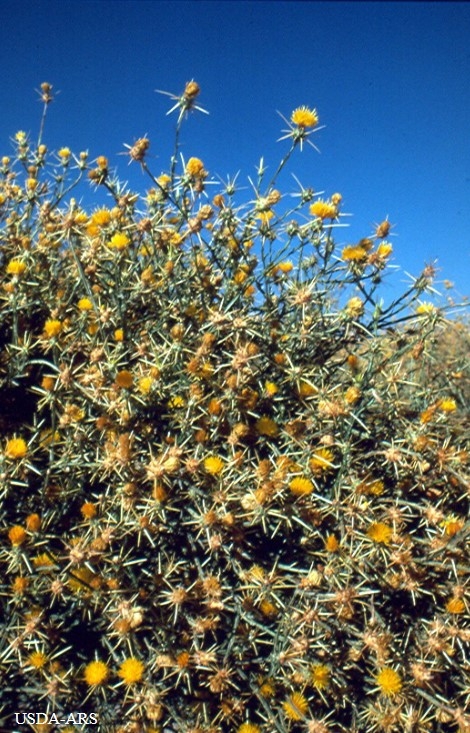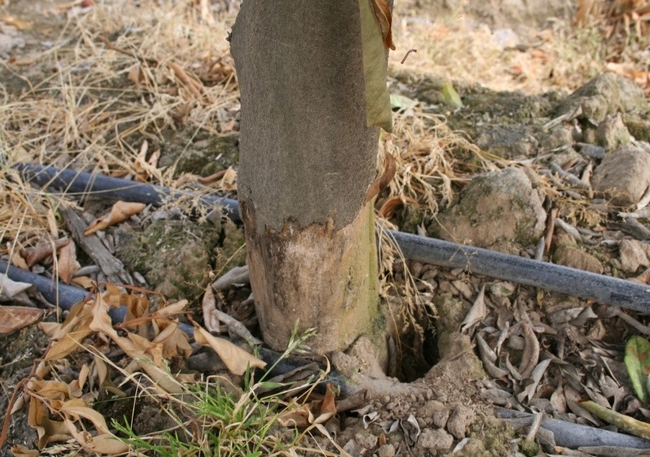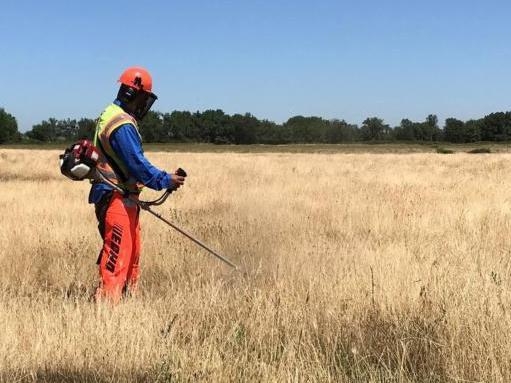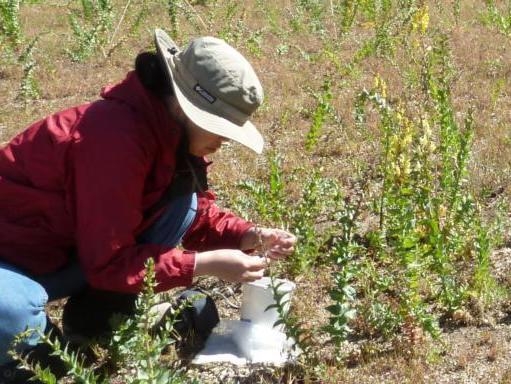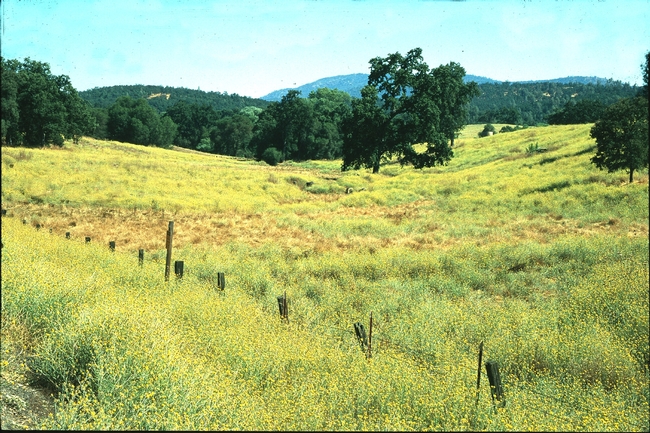This manual provides comprehensive descriptions of 21 commonly used non-chemical weed control techniques and of biological control agents for 18 weed species/species groups that will help you as a practitioner treat weeds more effectively.
Authors of each chapter have compiled research and on-the-ground knowledge of subject experts on tools and methods of application, as well as on efficacy of techniques under various environmental conditions and across different classes of invasive plants. Environmental, cultural, and human safety risks are also highlighted to help support safe and effective use of techniques. This manual is designed to be a go-to resource for practitioners that are either complementing their weed control work with non-chemical techniques or are exclusively restricted to not using herbicides. Individual BMPs will be incorporated into an online decision support tool still in development.
There is a section on biological control agents. Approved biological control agents can be distributed within California without a permit, and most can also be distributed across state lines (based on prior permits). The main exception is when an agent that has been approved by USDA-APHIS has not been approved for California (e.g. Aceria malherbae for field bindweed) or whose permit was rescinded (Diorhabda spp. for saltcedar).
The best source of information is:
Smith, L., Pitcairn, M.J., Moran, P.J. 2020. Biological Control, pp. 193-291. In: Best Management Practices for Non-Chemical Weed Control. Report to the California Department of Pesticide Regulation under grant number 18-PML-G002. California Invasive Plant Council. 291 p. 115 p.
https://www.cal-ipc.org/resources/library/publications/non-chem/
This is a free pdf document that has chapters on each target weed that has approved biological control agents in California.
Regarding yellow star thistle, 6 agents have been released in California and were widely distributed. In general, only a few of these are abundant enough to have impact, and some of them do better than others in specific habitats. For example, the hairy weevil (Eustenopus villosus) is more abundant in the Sierra Foothills and Coastal Hills and the false peacock fly (Chaetorellia succinea) is more abundant in the Central Valley. However, it is possible that they are not necessarily established at your particular site. It's recommended to first look to see what is there already. If insects are present, then it is not worth releasing more, but you may be able to adjust your integrated management plan to take advantage of their presence (see recommendations in the above BMP document. The hairy weevil and false peacock fly are the most abundant species in California. The newly-approved rosette weevil (Ceratapion basicorne) is being multiplied by CDFA, and is not yet widely available.
Best Management Practices for Non-Chemical Weed Control
This manual is available as a free download. Click here for a PDF of BMP for Non-Chemical Weed Control. (291 pp., 21.5 MB)
- Contents:
- Removing Whole Plants (5 techniques)
- Controlling Plants by Cutting (6 techniques)
- Controlling Plants in Place (3 techniques)
- Covering Plants with Sheet Barriers (3 techniques)
- Controlling Plants at a Plant Community Scale (4 techniques)
- Biological Control (general introduction and descriptions of agents for 18 weed species/species groups)
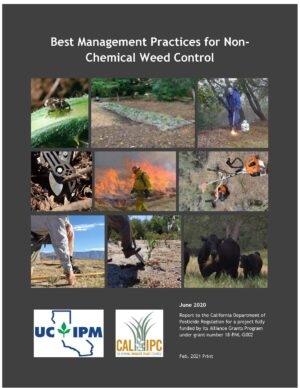
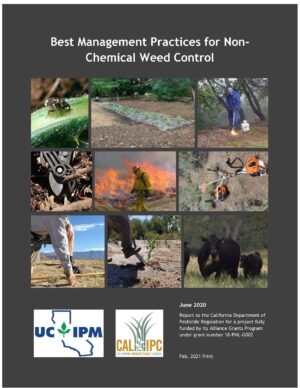
DPR Non-Chemical BMP Report Cover-300x388
Posted on
Monday, August 7, 2023 at
8:55 AM
Focus Area Tags: Agriculture
Dr. Roger Baldwin, Cooperative Extension Specialist in Human-Wildlife Conflict Resolution in the Department of Wildlife, Fish, and Conservation Biology at UC Davis, discussed the management of voles, rats, and mice in agricultural fields with a particular emphasis on an IPM approach. He covered a variety of management tools including biocontrol, habitat modification, trapping, rodenticides, and fumigants. The webinar was recorded on October 26, 2022 and targeted to growers and pest management professionals. For Master Gardeners and others serving home environments, please note that management methods, especially any pesticides mentioned, are not to be used without a clear understanding of their legal use. Continuing Education credits are not available for recorded webinars. Closed captions are being reviewed for accuracy and will be corrected as necessary. Speaker: Dr. Roger Baldwin, University of California Cooperative Extension Specialist, UC Davis.
Hear Him speak Here
Watch other recorded webinars https://www.youtube.com/playlist?list... Visit https://ucanr.edu/sites/ucexpertstalk/ for information about webinars. Visit http://ipm.ucanr.edu/training/ for information about UC IPM online courses.
Image: Vole damage to tree trunk
Posted on
Friday, December 2, 2022 at
7:27 AM
Focus Area Tags: Agriculture
April 20 (9 - 11 AM)
Seminar/Webinar Topic
Vertebrate Pests
CE Units Available
Speaker & Topic:
Rebecca Barboza, California Department of Fish and Wildlife. Speaking on Mounain Lion ecology, general facts, status in California, CDFW policies, and conflict prevention.
Jim Hartman, Deputy Agricultural Commissioner/Sealer, Integrated Pest Management Division, Los Angles County Agricultural Comissioner/Weights and Measures. Speaking about IPM techniques to prevent and manage damage from pocket gophers & ground squirrels to include the use exclusion, habitat modification, trapping and rodenticide.
Click Here for the April Webinar Registeration
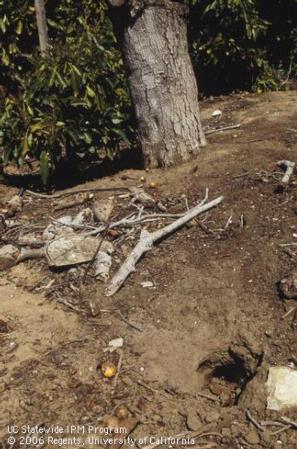
ground squirrel hole
Posted on
Friday, April 15, 2022 at
6:44 AM
Focus Area Tags: Agriculture
|
View as a webpage
|
ARS News Service
|
A New Technology for Environmentally Safe Pest Control Discovered Inside Insect Cells
For media inquiries contact: Janice López-Muñoz, (301) 793-7007
August 27, 2021
If you feel you are in a continuous search to have a fire ant free home lawn, you are not alone. These invasive and common insect pests are difficult to control and come back as uninvited guests over and over.
The good news is that USDA's Agricultural Research Service (ARS) scientists, recently discovered a new technology that is safer than pesticides to control fire ants and keep them away. The technology, known as "receptor interference" (RECEPTOR-i), disrupts the vital processes (e.g. feeding, digestion, and development) needed for fire ants to survive, resulting in a natural biological control strategy.
"The concept and procedure for RECEPTOR-i has been developed over years," said Man-Yeon Choi, Research Entomologist at the ARS Horticultural Crops Research Laboratory in Corvallis, OR. "Now it is a proven technology that will serve as a model for other pest management strategies such as for spotted wing drosophila, thrips and pest slugs."
The research published by Biomolecules, establishes how RECEPTOR-i technology uses the fire ants own cell components to target and screen for the small proteins needed to disrupt the insect's vital processes resulting in negative effects on their survival. Using the insects own cells is key to the success of RECEPTOR-i, since those small proteins can be obtained within 2-3 weeks versus other pest control strategy approaches that take longer and are more expensive.
"The RECEPTOR-i active ingredients are biodegradable, having no environmental impact and since it is species specific, it is not expected to affect other insects," said Robert Vander Meer, Research Leader at the ARS Imported Fire Ant and Household Insects Research Laboratory in Gainesville, FL. "This technology is broadly applicable to animal pests and the speed of discovery makes it ideal for developing a rapid control response to new invasive insects."
The use of this natural pest control technology will depend on the target insect. In the case of fire ants, it will be put together in a sucrose solution and presented for feeding in a bait station. For other pest insects the application of this technology will depend on the target insect's feeding type, e.g., chewing, caterpillars, piercing or sucking, mosquitoes and crop pest insects.
Fire ant control costs American households billions of dollars every year, hence developing effective and safer pest control strategies will be a great benefit to families and other economic sectors affected by fire ants. More research will take place for field experiments that will provide the data needed to stimulate commercial interest and get this technology to homeowners and others needing fire ant control.
The Agricultural Research Service is the U.S. Department of Agriculture's chief scientific in-house research agency. Daily, ARS focuses on solutions to agricultural problems affecting America. Each dollar invested in agricultural research results in $17 of economic impact.
|
| |
|
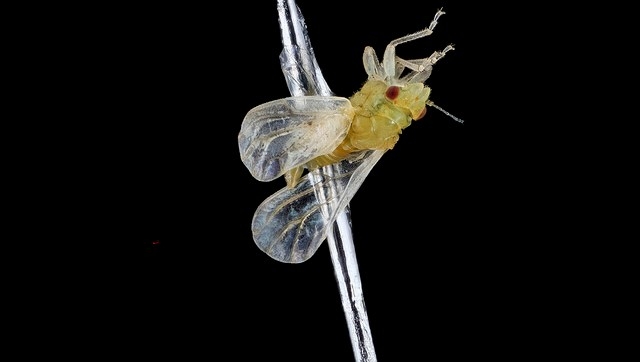
ACP mounted
Posted on
Tuesday, October 5, 2021 at
8:31 AM
Focus Area Tags: Agriculture
California has abundant wildlands — forests, rangeland, open areas, wildlife refuges and national, state, and local parks — that need protection from invasive plants. Invasive plants affect all Californians by increasing wildfire potential; reducing water resources; accelerating erosion and flooding; threatening wildlife; degrading range, crop and timberland; and diminishing outdoor recreation opportunities. According to the California Invasive Plant Council (Cal-IPC), more than 200 identified plant species harm California's wildlands.
Cal-IPC and the University of California Statewide Integrated Pest Management Program (UC IPM), with funding from the California Department of Pesticide Regulation (DPR) Alliance Grants Program, developed two resources that provide land managers access to the latest information on non-herbicide practices for managing weeds in wildlands. Best Management Practices for Non-Chemical Weed Control is a free downloadable manual. The same information has been incorporated into an interactive online tool called WeedCUT (Weed Control User Tool: weedcut.ipm.ucanr.edu).
"We anticipate WeedCUT will increase the use of more mechanical, physical, or biological practices, and potentially result in the reduction of herbicides used to manage wildland invasive weeds," said area IPM advisor emeritus Cheryl Wilen. "Best Management Practices for Non-Chemical Weed Control and WeedCUT were developed so land managers can become more knowledgeable and skilled in the use of non-herbicide methods as part of an IPM program.”
Knapweed control with a brush cutter. (Photo: Dawn Cunningham)
Best Management Practices for Non-Chemical Weed Control provides comprehensive descriptions of 21 commonly used non-herbicide weed control techniques and biological control agents for 18 invasive plants. Each chapter is the synthesis of research and on-the-ground knowledge from practitioners about non-herbicide methods. The chapters describe how a technique is best applied, the types of invasive plants and environmental conditions where it is most effective, and what its shortfalls might be. Environmental, cultural, and human safety risks are highlighted to help support the safe and effective use of these methods.
WeedCUT is the online version and can be used to learn about the different non-herbicide management methods, including the section on biological control. To filter through the database and learn which management practice to consider for a particular site and invasive plant type, a simple interface allows users to pick characteristics that describe their site and invasive plant problem. The tool then filters through the database to display the practices ranked by efficacy (excellent, good, fair, poor or ineffective). As in the manual, use of the technique and potential hazards are covered.
Best Management Practices for Non-Chemical Weed Control and WeedCUT are designed to be the go-to resources for practitioners that complement their conventional weed management work with non-herbicide techniques or are restricted in their use of herbicides. Both resources will help practitioners manage weeds more effectively.
Person releasing weevils for the biological control of Dalmatian toadflax. (Photo: Lincoln Smith USDA-ARS)
“Many experts in the field have contributed to create the manual and WeedCUT. It has been exciting to see these techniques described and reviewed so carefully. We're looking forward to seeing land managers, as well as all folks fighting weeds, incorporating the information from the manual and WeedCUT into their work,” said Jutta Burger, science program director and project lead with Cal-IPC.
While the manual and tool focus on non-herbicide methods, the hope is future funding can be found to continue the work and integrate herbicide options online.
"Land managers typically use both herbicide and non-herbicide methods, alone and in combination, to manage invasive plants in wildlands," said UC Cooperative Extension advisor and UC IPM-affiliated advisor Tom Getts. "A tool that combined both herbicide and non-herbicide methods would guide land managers to determine the most effective overall management program for their particular site."
Yellow starthistle is an invasive rangeland weed. (Photo: J. M. DiTomaso)
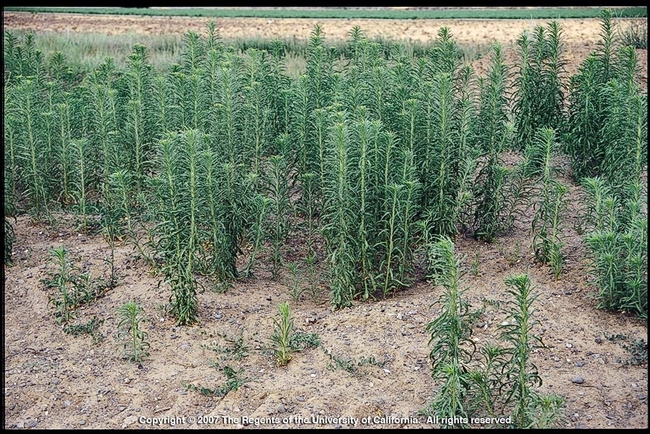
horseweed mature
Posted on
Wednesday, July 14, 2021 at
8:12 AM
- Author:
Tunyalee A. Martin, Jutta Burger, Cheryl A. Wilen, Thomas Getts
Focus Area Tags: Agriculture


